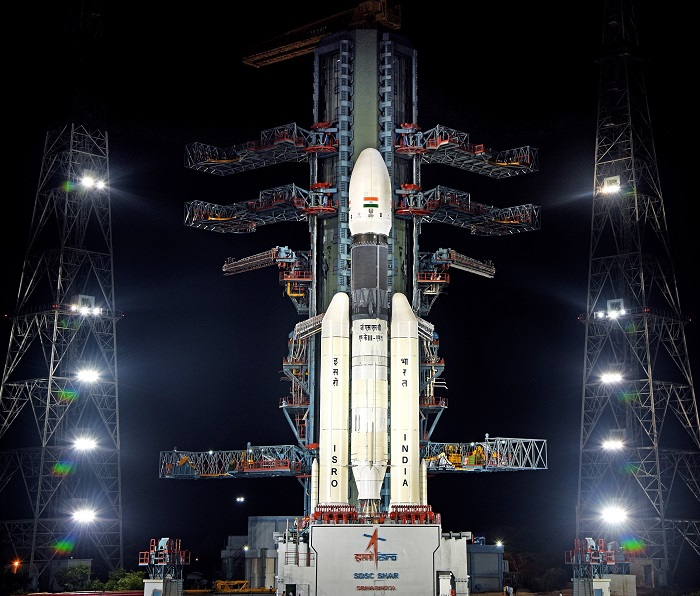India’s Geosynchronous Satellite Launch Vehicle GSLV MkIII-M1, successfully launched the 3840 kg Chandrayaan-2 spacecraft into an earth orbit (July 22, 2019). The spacecraft is now revolving round the earth with a perigee (nearest point to Earth) of 169.7 km and an apogee (farthest point to Earth) of 45,475 km. Today’s flight marks the first operational flight of the GSLV Mk III.
After a smooth countdown lasting 20 hours, GSLV MkIII-M1 vehicle majestically lifted off from the Second Launch Pad at the Satish Dhawan Space Centre SHAR (SDSC SHAR), Sriharikota at the scheduled launch time of 1443Hrs (2:43 pm) Indian Standard Time (IST) with the ignition of its two S200 solid strap-on motors. All the subsequent flight events occurred as scheduled.
bout 16 minutes 14 seconds after lift-off, the vehicle injected Chandrayaan-2 spacecraft into an elliptical earth orbit. Immediately after spacecraft separation from the vehicle, the solar array of the spacecraft automatically got deployed and ISRO Telemetry, Tracking and Command Network (ISTRAC), Bengaluru successfully took control of the spacecraft. The mission objective of Chandrayaan-2 is to develop and demonstrate the key technologies for end-to-end lunar mission capability, including soft-landing and roving on the lunar surface. On the science front, this mission aims to further expand our knowledge about the Moon through a detailed study of its topography, mineralogy, surface chemical composition, thermo-physical characteristics and atmosphere leading to a better understanding of the origin and evolution of the Moon.
After leaving earth orbit and on entering Moon's sphere of influence, the on-board propulsion system of Chandrayaan-2 will be fired to slow down the spacecraft. This will enable it to be captured into a preliminary orbit around the Moon. Later, through a set of manoeuvres, the orbit of Chandrayaan-2 around the moon will be circularised at 100 km height from the lunar surface.
Subsequently, the lander will separate from the Orbiter and enters into a 100 km X 30 km orbit around the Moon. Then, it will perform a series of complex braking maneuvers to soft land in the South polar region of the Moon on September 7, 2019.
Following this, the Rover will roll out from the lander and carries out experiments on the lunar surface for a period of 1 lunar day, which is equal to 14 Earth days. The mission life of the lander is also 1 lunar day.The Orbiter will continue its mission for a duration of one year.
The orbiter had a lift-off weight of about 2,369 kg, while the lander and rover weighed 1,477 kg and 26 kg respectively. The rover can travel up to 500 m (half a kilometre) and relies on electric power generated by its solar panel for functioning.
Chandrayaan-2 has several science payloads to facilitate a more detailed understanding of the origin and evolution of the Moon. The Orbiter carries eight payloads, the lander carries three, and the rover carries two. Besides, a passive experiment is included on the lander.The Orbiter payloads will conduct remote-sensing observations from a 100 km orbit while the Lander and Rover payloads will perform in-situ measurements near the landing site.
The ground facilities constitute the third vital element of Chandrayaan-2mission. They perform the important task of receiving the health information as well as the scientific data from the spacecraft. They also transmit the radio commands to the spacecraft. The Ground Segment of Chandrayaan-2 consists of Indian Deep Space Network, Spacecraft Control Centre and Indian Space Science Data Centre.
Interesting facts about Chandrayaan 2
- Chandrayaan 2 cost Rs 978 crore (around $140 million)
- With Chandrayaan 2's landing on the Moon surface, India will be the 4th country in the world after the United States, Russia and Chin to land on the lunar surface.
- The lift-off mass of Chandrayaan-1 was 1380 kg and lift-off mass of Chandrayaan 2 is about 3,850 kg
- It cost is less than Avengers: Endgame cost Rs 2,443 crore (around $356 million)
- Chandrayaan-2 will try to land near the little-explored south pole of the Moon.
- On Monday, July 22, Isro has made a second attempt to launch the ambitious mission to explore the uncharted South Pole of Moon.
- The lander of Chandrayaan 2 has been named Vikram after the father of India's space programme, Dr Vikram A Sarabhai.
- It is first expedition by Isro to attempt a soft landing on the lunar surface equipped with "home grown" technology. It would also be the first mission to explore the lunar terrain.
- Chandrayaan-2 consists of three components: the orbiter, the lander and the rover.
- After successful landing on the Moon surface would be First country to reach South Pole of moon.
Siurce: ISRO
